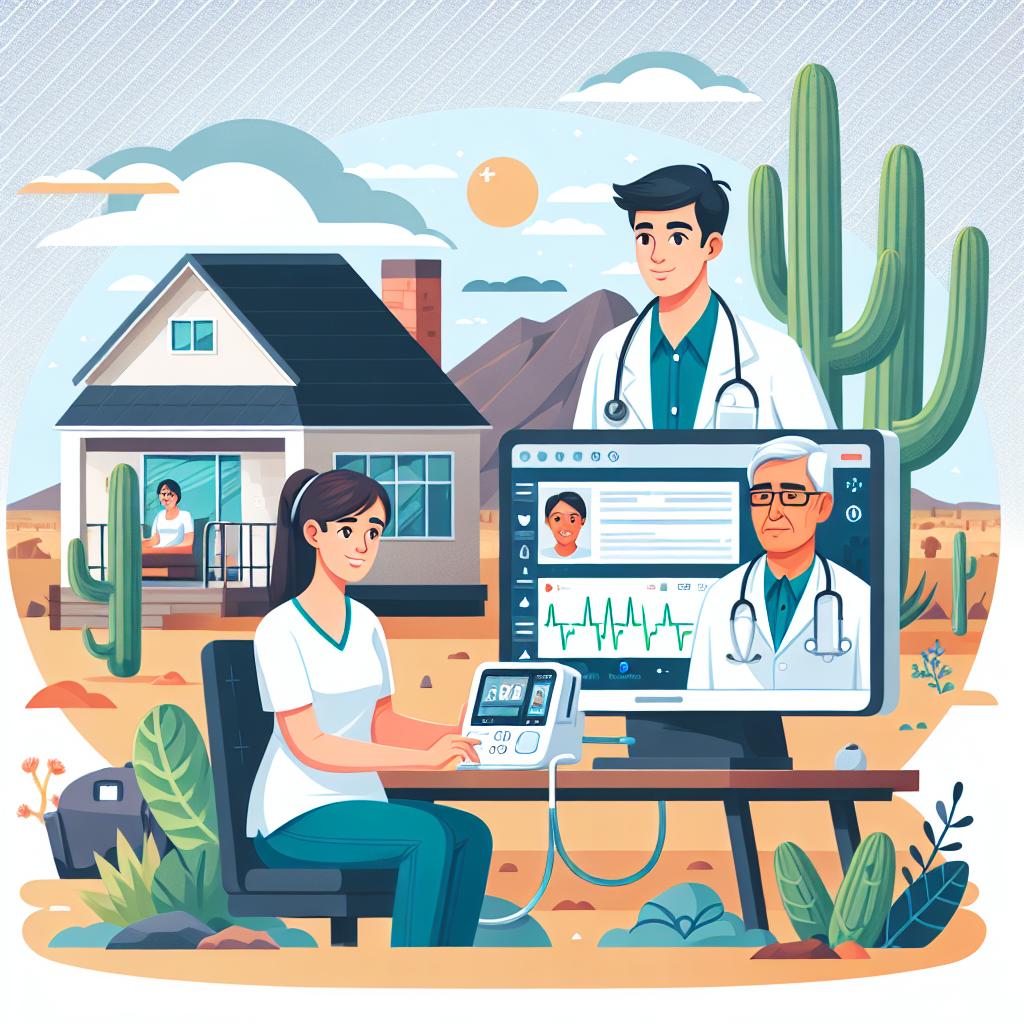Arizona Agency Enhances Home Health with Telehealth and Remote Patient Monitoring

In recent years, the integration of telehealth and remote patient monitoring (RPM) has revolutionized the healthcare landscape, offering innovative solutions to improve patient care and accessibility. Arizona, a state known for its progressive approach to healthcare, has been at the forefront of this transformation. This article explores how an Arizona agency is enhancing home health services through the strategic implementation of telehealth and RPM technologies. We will delve into the benefits, challenges, and future prospects of these advancements, supported by case studies and statistical data.
The Rise of Telehealth in Arizona
Telehealth has emerged as a critical component of healthcare delivery, especially in regions with vast rural areas like Arizona. The state’s healthcare agencies have recognized the potential of telehealth to bridge the gap between patients and healthcare providers, ensuring that quality care is accessible to all, regardless of geographical constraints.
Arizona’s telehealth initiatives have been driven by several factors, including the need to address the shortage of healthcare professionals in rural areas, the desire to reduce healthcare costs, and the aim to improve patient outcomes. The state’s commitment to telehealth is evident in its legislative support and investment in telehealth infrastructure.
One of the key drivers of telehealth adoption in Arizona is the state’s large rural population. According to the U.S. Census Bureau, approximately 10% of Arizona’s population lives in rural areas, where access to healthcare services can be limited. Telehealth offers a viable solution by enabling patients to connect with healthcare providers remotely, reducing the need for long-distance travel and minimizing the burden on rural healthcare facilities.
Moreover, telehealth has proven to be a cost-effective solution for both patients and healthcare providers. By reducing the need for in-person visits, telehealth can lower transportation costs for patients and decrease overhead expenses for healthcare facilities. This financial benefit has been a significant motivator for the adoption of telehealth services in Arizona.
Arizona’s legislative support for telehealth has also played a crucial role in its widespread adoption. The state has implemented policies that promote telehealth reimbursement, ensuring that healthcare providers are compensated for telehealth services at rates comparable to in-person visits. This has incentivized providers to incorporate telehealth into their practice, further expanding access to care.
Remote Patient Monitoring: A Game Changer in Home Health
Remote patient monitoring (RPM) is another technological advancement that is transforming home health services in Arizona. RPM involves the use of digital devices to collect and transmit patient data to healthcare providers, allowing for continuous monitoring and timely interventions.
The benefits of RPM are manifold. For patients with chronic conditions, RPM offers a convenient way to manage their health from the comfort of their homes. By regularly monitoring vital signs such as blood pressure, glucose levels, and heart rate, patients can gain better control over their health and avoid complications that may require hospitalization.
For healthcare providers, RPM provides valuable insights into a patient’s health status, enabling them to make informed decisions and tailor treatment plans accordingly. This proactive approach can lead to improved patient outcomes and reduced healthcare costs by preventing hospital readmissions and emergency room visits.
Arizona’s healthcare agencies have been quick to recognize the potential of RPM in enhancing home health services. Several pilot programs have been launched across the state, demonstrating the effectiveness of RPM in managing chronic conditions such as diabetes, hypertension, and heart disease.
One notable example is a pilot program conducted by an Arizona-based healthcare agency, which implemented RPM for patients with heart failure. The program involved the use of wearable devices to monitor patients’ heart rate and activity levels, with data transmitted to healthcare providers in real-time. The results were promising, with a significant reduction in hospital readmissions and improved patient satisfaction.
Statistics further underscore the impact of RPM on home health services. According to a study published in the Journal of Medical Internet Research, RPM can reduce hospital readmissions by up to 50% and decrease healthcare costs by 25%. These findings highlight the potential of RPM to revolutionize home health care in Arizona and beyond.
Challenges and Solutions in Implementing Telehealth and RPM
While the benefits of telehealth and RPM are undeniable, their implementation is not without challenges. One of the primary obstacles is the digital divide, which refers to the gap between individuals who have access to digital technologies and those who do not. In Arizona, this divide is particularly pronounced in rural areas, where internet connectivity may be limited or unreliable.
To address this issue, Arizona’s healthcare agencies have been working to expand broadband access in underserved areas. The state has partnered with telecommunications companies to improve infrastructure and provide affordable internet services to rural communities. Additionally, initiatives such as the Arizona Broadband for Education Initiative aim to enhance digital literacy and ensure that residents have the skills needed to utilize telehealth and RPM technologies effectively.
Another challenge is the integration of telehealth and RPM into existing healthcare systems. Healthcare providers may face difficulties in adapting to new technologies and workflows, which can hinder the adoption of telehealth and RPM services. To overcome this barrier, Arizona’s healthcare agencies have been providing training and support to healthcare professionals, ensuring that they are equipped with the knowledge and skills needed to deliver telehealth and RPM services effectively.
Data security and privacy concerns also pose a significant challenge in the implementation of telehealth and RPM. With the increasing use of digital technologies in healthcare, there is a heightened risk of data breaches and unauthorized access to patient information. To mitigate these risks, Arizona’s healthcare agencies have implemented robust security measures, including encryption and secure data transmission protocols, to protect patient data and ensure compliance with regulations such as the Health Insurance Portability and Accountability Act (HIPAA).
Despite these challenges, the potential of telehealth and RPM to transform home health services in Arizona is immense. By addressing these obstacles and leveraging the benefits of these technologies, Arizona’s healthcare agencies can enhance patient care and improve health outcomes across the state.
Case Studies: Success Stories from Arizona
Several case studies from Arizona highlight the successful implementation of telehealth and RPM in enhancing home health services. These examples demonstrate the potential of these technologies to improve patient care and outcomes.
One notable case study involves a telehealth program implemented by a healthcare agency in Phoenix, Arizona. The program focused on providing telehealth services to patients with chronic obstructive pulmonary disease (COPD), a condition that requires regular monitoring and management. Through telehealth consultations, patients were able to receive timely medical advice and support from healthcare providers, reducing the need for in-person visits and hospitalizations. The program resulted in a 30% reduction in hospital admissions and a 40% decrease in emergency room visits, highlighting the effectiveness of telehealth in managing chronic conditions.
Another success story comes from a rural healthcare facility in northern Arizona, which implemented RPM for patients with diabetes. The program involved the use of glucose monitoring devices that transmitted data to healthcare providers in real-time. This allowed for continuous monitoring of patients’ blood sugar levels and timely interventions when necessary. The program led to improved glycemic control among patients and a significant reduction in diabetes-related complications, demonstrating the potential of RPM to enhance home health services in rural areas.
These case studies underscore the transformative impact of telehealth and RPM on home health services in Arizona. By leveraging these technologies, healthcare agencies can improve patient care, reduce healthcare costs, and enhance health outcomes across the state.
The Future of Telehealth and RPM in Arizona
The future of telehealth and RPM in Arizona looks promising, with continued advancements in technology and increasing support from healthcare agencies and policymakers. As these technologies become more integrated into healthcare systems, they have the potential to revolutionize home health services and improve patient care across the state.
One area of growth is the expansion of telehealth services to include a wider range of medical specialties. While telehealth has traditionally been used for primary care and chronic disease management, there is increasing interest in its application for specialties such as mental health, dermatology, and cardiology. This expansion will enable more patients to access specialized care remotely, further enhancing the accessibility and convenience of healthcare services.
Another promising development is the integration of artificial intelligence (AI) and machine learning into telehealth and RPM technologies. These advancements have the potential to enhance the accuracy and efficiency of remote monitoring, enabling healthcare providers to make more informed decisions and deliver personalized care to patients.
Furthermore, the continued investment in broadband infrastructure and digital literacy initiatives will help bridge the digital divide and ensure that all residents of Arizona have access to telehealth and RPM services. By addressing these barriers, Arizona’s healthcare agencies can ensure that the benefits of these technologies are accessible to all, regardless of geographical location or socioeconomic status.
In conclusion, the integration of telehealth and remote patient monitoring into home health services in Arizona represents a significant advancement in healthcare delivery. By leveraging these technologies, Arizona’s healthcare agencies can enhance patient care, improve health outcomes, and reduce healthcare costs. As these technologies continue to evolve, they hold the potential to transform the healthcare landscape in Arizona and beyond.
Conclusion
In summary, the integration of telehealth and remote patient monitoring into home health services in Arizona has the potential to revolutionize healthcare delivery in the state. By addressing the challenges of access, cost, and quality, these technologies offer innovative solutions to improve patient care and outcomes. Through legislative support, investment in infrastructure, and the successful implementation of pilot programs, Arizona’s healthcare agencies are leading the way in leveraging telehealth and RPM to enhance home health services.
The success stories and case studies from Arizona demonstrate the transformative impact of these technologies on patient care. As telehealth and RPM continue to evolve, they hold the promise of further improving healthcare accessibility, efficiency, and quality across the state. By embracing these advancements, Arizona’s healthcare agencies can ensure that all residents have access to high-quality, patient-centered care, regardless of their location or circumstances.
As we look to the future, the continued integration of telehealth and RPM into home health services in Arizona will be crucial in addressing the evolving healthcare needs of the state’s population. By leveraging these technologies, Arizona can continue to lead the way in innovative healthcare delivery, setting an example for other states to follow.




